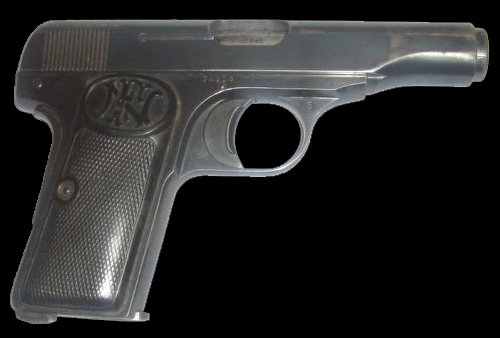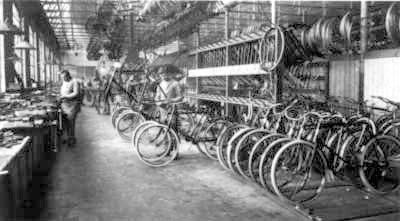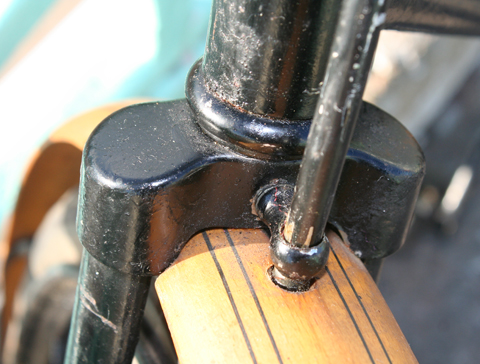

Franz Ferdinand (18 December 1863 – 28 June 1914) was an Archduke of Austria-Este, Austro Hungarian and Royal Prince of Hungary and of Bohemia, and from 1889 until his death, heir presumptive to the Austro-Hungarian throne. His assassination in Sarajevo precipitated Austria-Hungary’s declaration of war against Serbia. This caused countries allied with Austria-Hungary (the Triple Alliance) and countries allied with Serbia (the Triple Entente Powers) to declare war on each other, starting World War I.
FN-Herstal were indirectly responsible for the outbreak of WW1. The company produced the first Browning semi-automatic pistol in 1899. The final version with a shorter barrel, Model 1900, was adopted by the Belgian army. The weapon used by Gavrilo Princip to assassinate Franz Ferdinand of Austria in 1914 was its successor, a Browning 9mm 1910 Court No. 19074. (Also known as 9mm Short, 9mm Corto, 9mm Kurz, etc depending on language).


1920s FN Gents Chainless
Sold by Cycles Hoboken as ‘The Rapid’
24″ Frame
28″ Wheels
FN Named Saddle
Wooden Mudguards
Celluloid Handlebar

FN of Belgian established a good trade with their chainless bicycle. Until German companies copied it, the FN was the market leader in shaft-drive bicycles throughout Europe. The Dutch cycle business ‘G. Onkelinx’ of Antwerp purchased FN Chainless bicycles for local resale. Their cycle shop ‘Cycles Hoboken’ rebadged it as ‘The Rapid.’
This is a rare surviving example of the FN ‘Rapid’. It’s in good unrestored functional condition, its only negative point being a missing gear cover over the rear hub (a home-made cover has been fitted). The FN name on the sides of the saddle are worn, but you can still just about see them. The wooden mudguards and celluloid handlebar are charming accessories, typical of Dutch bicycles of the era. It’s ready to ride.






1926 FN CATALOGUE EXTRACTS



















REAR HUB BRAKE & GEAR




BRIEF HISTORY of FN HERSTAL
FABRIQUE NATIONALE d’ARMES de GUERRE

Weapons manufacturing in the Belgian city of Liège began as early as the 16th century. By the second half of the nineteenth century, the city featured a number of prominent arms manufacturers. In 1886, a group of manufacturers, including Ancion, Dumoulin Frères, Dresse-Laloux & Cie., J. Hanssen, and Pirlot-Frésart joined together to form an association, Les Fabricants d’Armes Réunis (United Arms Manufacturers).
An order from the Belgian Army in 1887 for 150,000 repeating rifles encouraged Les Fabricants d’Armes Réunis to begin planning a new, large scale factory, and in 1888 the group created a new company, Fabrique Nationale d’Armes de Guerre. The new factory was built in Herstal, and in 1889 the company launched production of the Belgian army order, producing Mauser-designed rifles under license. Mauser, based in Germany, then bought up the company from its founders.
At the completion of that contract, the Belgian army returned to the company, later to become known as FN Herstal, with an order for 30 million rounds for the Mauser rifles. FN Herstal promptly set up a dedicated munitions factory next to its rifle production site in 1891.
FN Herstal soon expanded its production to include civilian arms, especially hunting rifles. By the mid-1890s, the company began seeking other production areas, and in 1896 the company launched production of its own line of bicycles, including its own ‘acatene’ or chainless bicycle designs. The company would remain a popular producer of bicycles for some 30 years.
According to the advert below, from Cycling magazine of 20th November, 1919, the address of F.N. (England) Ltd was Kimberley Rd, Willesden Lane, London NW6.

From bicycles, FN Herstal entered the young automotive market, producing its first car in 1900 and its first motorcycle two years later.

While the company stopped producing cars in 1937, it continued to build motorcycles into the 1960s. In addition, FN Herstal became a prominent truck manufacturer, with production running from 1930 to 1966, and also built trolleys between 1932 and 1955.


















FN SADDLE

The FN saddle is in good condition …except that, after a hundred years of use, the FN name and motif has worn off the sides.

























































